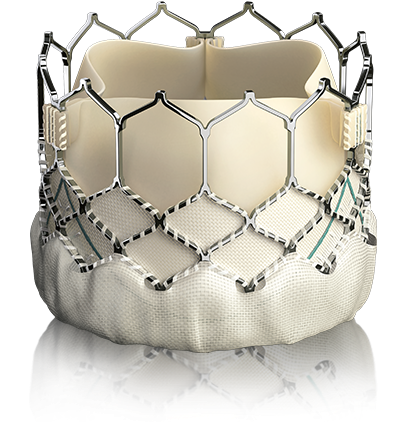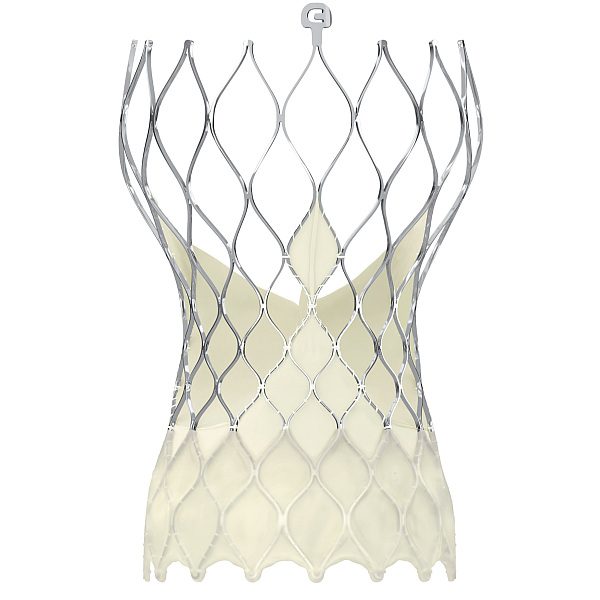
A rendering of the SAPIEN Transcatheter Heart Valve, which can expand to 23 or 26 millimeters.
Image copyright Edwards Lifesciences LLC.
 |
|
A rendering of the SAPIEN Transcatheter Heart Valve, which can expand to 23 or 26 millimeters. |
The heart has four chambers—two upper chambers called the left and right atriums, and two lower chambers called the left and right ventricles. Within these four chambers are four valves that control the flow of blood through the heart by opening and closing: the aortic, mitral, pulmonary and tricuspid valves. When your heart
beats and pumps blood through these valves, the valves contract or squeeze.
Aortic stenosis is when a valve is too narrow to pump blood effectively, due to calcium buildup, high cholesterol or a birth defect. Aortic regurgitation is when a valve cannot close fully, causing blood to leak backward through the valve. Both problems cause your heart to work harder, which can weaken heart muscle. Severe aortic stenosis is usually caused by calcium buildup over time. Without treatment, the heart can quickly deteriorate, increasing the risk for heart failure.
If the heart has to work harder to pump blood, this can reduce the body's ability to receive enough oxygen-rich blood. Patients with severe aortic stenosis often feel shortness of breath, chest pain or fatigue, or they may feel like they will pass out.
Severe aortic stenosis cannot be treated with medication. Patients can undergo aortic valve replacement, a surgical procedure that replaces the defective valve with a new mechanical or tissue valve. This procedure is performed through open-heart surgery, which requires patients to have their hearts pumped with a heart-lung
machine. However, age, a history of heart disease, or other health issues may prevent some patients from being able to undergo open-heart surgery. For those patients, there is a new treatment option called Transcatheter Aortic Valve Replacement (TAVR).
TAVR is a less invasive procedure in which the diseased aortic valve is replaced by inserting a balloon-expandable heart valve into the body through a tube called a catheter. This procedure is performed under general anesthesia while the heart is beating and therefore does not require use of the heart-lung machine. A small cut is made through the femoral artery, a very large artery in the upper leg, instead of the chest, and the catheter is inserted into the body through this incision to help transport the new valve. The valve is made from animal tissue and comes in two sizes: 23 millimeters and 26 millimeters in diameter.The operation takes about three hours, and afterward, patients are moved to the Intensive Care Unit. During your stay, your doctor will perform a physical exam, run blood tests and check your heart function using electrocardiography, ultrasound and X-rays. The average hospital stay is eight days.
 |
| Medtronic TAVR Valve |
Risks associated with TAVR include stroke, in which blood suddenly stops flowing to the brain; major vascular complications such as a tear or hole in the blood vessels or in the heart, which would require additional operations to correct; and blood loss. Within the first 30 days after the TAVR procedure, the short-term risks include infection, irregular heartbeat, difficulty exercising, pain at the incision, problems with breathing, and high or low blood pressure. Reduced heart function and bruising are also risks.
You should continue to have regular visits with your cardiologist and primary care doctor to ensure that your valve is performing properly and also that your symptoms are improving. If you experience any symptoms, such as shortness of breath or fatigue, please contact your doctor right away.